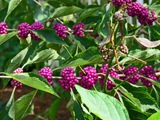
Beautyberry Berries
by CMG Betty J
American Beautyberry, Callicarpa americana, is a common shrub in the southern USA. This deciduous plant is usually 3-5’ high and wide but is sometimes as tall as 9’. It grows easily in shady, moist woods and near stream beds. Its native range extends from Kendall County in central Texas, east to Florida, north to Maryland, and as far south as Cuba and Bermuda. Named for its stunning display of vivid magenta fruit that contrasts with its light green leaves, it provides a good food supply for small mammals and birds including cardinals, mockingbirds, finches, and woodpeckers, long after the leaves have fallen. Some bushes produce white berries.

American Beautyberry, white berries
The leaves are simple and coarsely serrated on the perimeter. Many small white, pink, or red flowers grow at the leaf nodes and develop into the characteristic berry clusters in September and October. In autumn when the leaves drop, they leave behind the striking fruit clusters.

Beautyberry Flower
American Beautyberry is a popular landscape shrub for shady spots. It will survive in sun, however, supplemental watering may be required. Plant it as either a background shrub or a specimen planting. It would work especially well with a display that also included dogwood, button bush or holly. The arching branches offer a nice contrast to upright plants and trees.

Beautyberry Bush
If the bush is cut back to half its size every winter, it will grow more densely and produce more fruit. It can be easily propagated into landscapes damaged by clearing or livestock by planting fresh seeds or rooting soft cuttings.